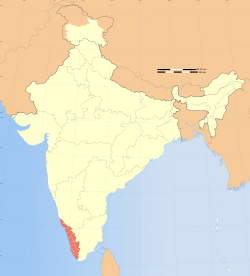Kerala Day
Kerala | |
|---|---|
 Location of Kerala in India | |
 Map of Kerala |
Kerala Piravi marks the birth of the state of Kerala in India. The state of Kerala was created on November 1, 1956. November 1 is therefore known as Kerala Piravi Dinam (day) in the state. Malayalees around the world celebrate November 1 as Kerala Piravi, which in Malayalam means "birthday of Kerala".
Kerala, the southernmost state of India, was formed long after Indian independence on 15 August 1947. Prior to that date it was three independent provinces named Malabar, Cochin and Travancore. Kerala originally got its name after the first ruler, Keralian Thamboran, who ruled one of these independent provinces earlier in the millennia. But some historians say that the name 'Kerala' comes from "kera", which means coconut tree which is widely seen in the region.
History
Mythology
Mythologically, Kerala stretches along the Arabian Sea from Gokarnam (Gokarna, in Karnataka) to Kanyakumari in Tamil Nadu. According to the Hindu myth Parashurama, incarnation of Mahavishnu (The God-Lord), created Kerala. Parasurama flung his "Mazhu" (axe) from Gokarnam (Gokarna) to the sea and the sea receded to form the land Keralam.
Pre-modern era
Prior to 1956, Kerala was made up of three distinct areas. Malabar, Cochin and Travancore.
Malabar forms the northern territory with Thallashery, Cannanore and Kasargode with a tiny pocket-handkerchief French possession of Mahe (which was returned to India in the early 1950s and is now administratively part of Pondicherry). This area belonged to what was once called the Madras Presidency under the British. The middle section is formed by the princely State of 'Cochin'; the third, Southern territory, comprises 'Travancore', another princely state.
A series of agitations for political rights and a popular Government begun in Travancore and Kochi early in this century and later joined by other provinces fetched independence in 1947 and the first popular Government took over from the British royal family. On July 1, 1949, Travancore and Kochi joined to form the unified Travancore-Cochin state. But Kerala continued to be politically divided till the 1950s, even in the midst of geographic similarities and solidarity of language.
A popular movement known as Aikya Kerala (meaning united Kerala), for the formation of the State of Kerala, gave an impetus to the reorganisation of the state on a linguistic basis.[1][2]
Formation of Kerala State and Modern era
The present day Kerala state was formed as result of the States Reorganisation Act of 1956, passed by the Government of India. It was a major reform of the boundaries of India's states and territories, organising them along linguistic lines. Kerala was formed by the merger of Travancore-Cochin state with the Malabar district of Madras State, Kasaragod of South Canara (Dakshina Kannada).
The modern Kerala is divided into fourteen districts with Thiruvananthapuram as the state capital. Kerala is one of the first place in the world where a Communist Ministry came into power by a general election in 1957.
Geography
Kerala is a 560 km long narrow stretch of land. At the widest, Kerala is 120 km from the sea to the mountains. On one side of Kerala are the lofty mountains ranging high to reach the sky. And on the other side the land is washed by the blue Arabian Sea waters. The land is covered with thick dense tropical forest, fertile plains, beautiful beaches, cliffs, rocky coasts, an intricate maze of backwaters, still bays and 44 rivers. Kerala's exotic spices have lured foreigners to her coast from time immemorial.[3][4]
Events
Nehru Trophy Boat Race of Alleppey is the largest water sports event.
References
- ^ http://www.manoramaonline.com/cgi-bin/mmonline.dll/portal/ep/gulfContentView.do?contentId=732939&programId=1073751464&channelId=-1073750346&BV_ID=@@@
- ^ http://articles.economictimes.indiatimes.com/2010-11-01/news/27577157_1_classical-status-travancore-malabar-region
- ^ Corn, Charles; Glasserman, Debbie (March 1999). The Scents of Eden: A History of the Spice Trade. Kodansha America. ISBN 1-56836-249-8.
- ^ Curtin PD (1984). Cross-Cultural Trade in World History. Cambridge University Press. p. 144. ISBN 0-521-26931-8.
